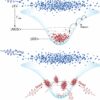Transporting energy is costly. When a current runs through conductive materials, some of the energy is lost due to resistance as particles within the material interact—just notice the warmth from your phone or laptop. This energy loss presents a hurdle to the advancement of many technologies and scientists are searching for ways to make superconductors that eliminate resistance.
Superconductors can also provide a platform for fault-tolerant quantum computing if endowed with topological properties. An example of the latter is the quantum Hall effect where the topology of electrons leads to universal, “quantized,” resistance with accuracy up to one part in a billion, which finds uses in meteorology. Unfortunately, the quantum Hall effect requires extremely strong magnetic fields, typically detrimental to superconductivity. This makes the search for topological superconductors a challenging task.
In two new papers in Physical Review Letters and Physical Review B UConn Physicist Pavel Volkov and his colleagues propose how to experimentally manipulate the quantum particles, called quasiparticles, in very thin layers of ordinary superconductors to create topological superconductors by slightly twisting the stacked layers.
Volkov explains there is a lot of research being done on ways to engineer materials by stacking layers of two-dimensional materials together:
“Most famously, this has been done with graphene. Stacking two graphene layers in a particular way results in a lot of interesting new phenomena. Some parallel those in high-temperature superconductors, which was unexpected because, by itself, graphene is not superconducting.”
Superconductivity happens when a material conducts current without any resistance or energy loss. Since resistance is a challenge for many technologies, superconducting materials have the potential to revolutionize how we do things, from energy transmission to quantum computing to more efficient MRI machines.
However, endowing superconductors with topological properties is challenging, says Volkov, and as of now, there are no materials that can reliably perform as topological superconductors.
The researchers theorize that there is an intricate relation between what happens inside the twisted superconductor layers and a current applied between them. Volkov says the application of a current makes the quasiparticles in the superconductor behave as if they were in a topological superconductor.
“The twist is essentially determining the properties, and funnily enough, it gives you some very unexpected properties. We thought about applying twisting to materials that have a peculiar form of superconductivity called nodal superconductivity,” says Volkov.
“Fortunately for us, such superconductors exist and, for example, the cuprate high-temperature superconductors are nodal superconductors. What we claim is that if you apply a current between two twisted layers of such superconductors, it becomes a topological superconductor.”
The proposal for current-induced topological superconductivity is, in principle, applicable at any twist angle, Volkov explains, and there is a wide range of angles that optimize the characteristics, which is unlike other materials studied so far.
“This is important because, for example, in twisted bilayer graphene, observation of interesting new phenomena requires to align the two layers to 1.1 degrees and deviations by .1 degrees are strongly detrimental. That means that one is required to make a lot of samples before finding one that works. For our proposal this problem won’t be as bad. If you miss the angle even by a degree, it’s not going to destroy the effect we predict.”
Volkov expects that this topological superconductor has the potential to be better than anything else currently on the market. Though one caveat is they do not know exactly what the parameters of the resulting material will be, they have estimates that may be useful for proof of principle experiments.
The researchers also found unexpected behaviors for the special value of twist angle.
“We find a particular value of the angle, the so-called ‘magic angle,’ where a new state should appear—a form of magnetism. Typically, magnetism and superconductivity are antagonistic phenomena but here, superconductivity begets magnetism, and this happens precisely because of the twisted structure of the layers.” says Volkov.
Demonstrating these predictions experimentally will bring more challenges to overcome, including making the atoms-thick layers better themselves and determining the difficult-to-measure parameters, but Volkov says there is a lot of motivation behind developing these highly complex materials.
“Basically, the main problem so far is that the candidate materials are tricky to work with. There are several groups around the world trying to do this. Monolayers of nodal superconductors, necessary for our proposal have been realized, and experiments on twisted flakes are ongoing. Yet, the twisted bilayer of these materials has not yet been demonstrated. That’s work for the future.”
These materials hold promise for improving materials we use in everyday life, says Volkov. Things already in use that take advantage of the topological states include devices used to set resistance standards with high accuracy. Topological superconductors are also potentially useful in quantum computing, as they serve as a necessary ingredient for proposals of fault-tolerant qubits, the units of information in quantum computing. Volkov also emphasizes the promise topological materials hold for precision physics,
“Topological states are useful because they allow us to do precision measurements with materials. A topological superconductor may allow us to perform such measurements with unprecedented precision for spin (magnetic moment of electron) or thermal properties.”
More information:
Pavel A. Volkov et al, Current- and Field-Induced Topology in Twisted Nodal Superconductors, Physical Review Letters (2023). DOI: 10.1103/PhysRevLett.130.186001
Pavel A. Volkov et al, Magic angles and correlations in twisted nodal superconductors, Physical Review B (2023). DOI: 10.1103/PhysRevB.107.174506
Provided by
University of Connecticut
Citation:
The exciting possibilities of tiny, twisted superconductors (2023, May 5)



